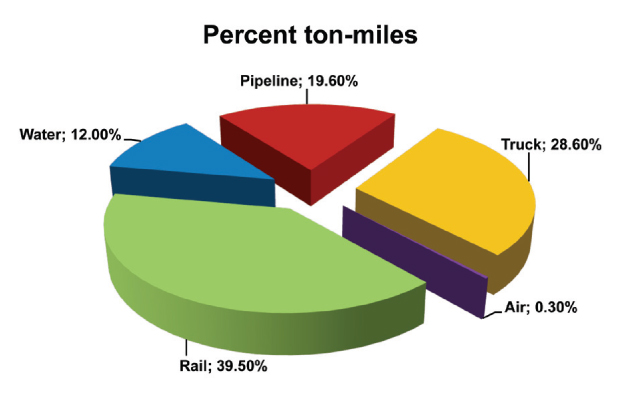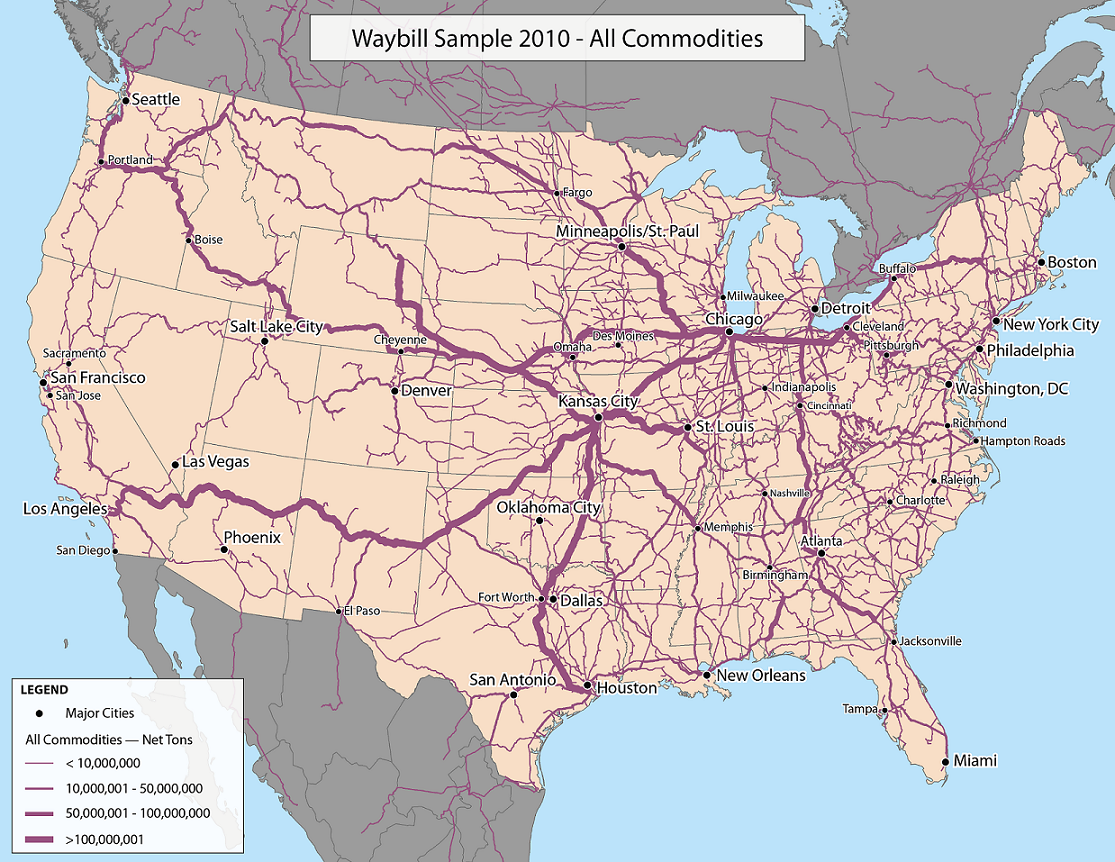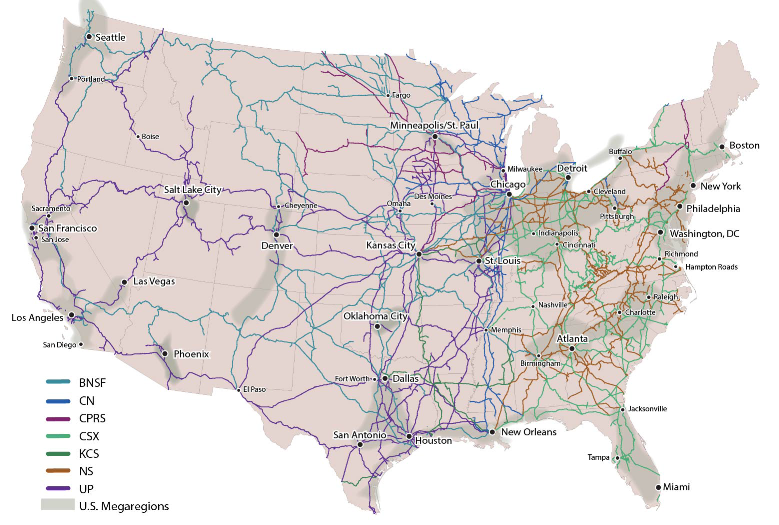Freight Rail Today
The Freight Rail Network How Freight Moves What Freight Moves Where Freight Moves The Future
The Freight Rail Network
Today, the U.S. freight rail network is widely considered one of the most dynamic freight systems in the world. The $60 billion industry consists of 140,000 rail miles operated by seven Class I railroads [1] (railroads with operating revenues of $433.2 million or more), 21 regional railroads, and 510 local railroads. [2] Not only does the 140,000 mile system move more freight than any other freight rail system worldwide but it also provides 221,000 jobs [3] across the country and numerous public benefits including reductions in road congestion, highway fatalities, fuel consumption and greenhouse gasses, logistics costs, and public infrastructure maintenance costs.
The U.S. freight railroads are private organizations that are responsible for their own maintenance and improvement projects. Compared with other major industries, they invest one of the highest percentages of revenues to maintain and add capacity to their system. The majority of this investment is for upkeep to ensure a state of good repair while 15 to 20 percent of capital expenditures, on average, are used to enhance capacity. [4]
The documents Freight Railroad Background and Impact of the Staggers Rail Act of 1980 offer more information about the current state of the U.S. freight rail industry. In addition, FRA's Railroad Geographic Information System provides an interactive tool that allows users to view various aspects of freight rail infrastructure in the U.S. Public datasets are available in the National Transportation Atlas Database.
[1] The seven Class I freight railroads are: BNSF Railway, CSX Transportation, Grand Trunk Corporation, Kansas City Southern Railway, Norfolk Southern Combined Railroad Subsidiaries, Soo Line Railroad, and Union Pacific Railroad.
[2] Federal Railroad Administration, "Freight Railroad Background", March 2012.
[3] Association of American Railroads, “An Overview of America’s Freight Railroads”, July 2012.
[4] Federal Railroad Administration, "National Rail Plan Progress Report", September 2010.
How Freight Moves

On the rails, in general, bulk freight, such as grain and coal, ships in rail cars and consumer goods, such as items found at a neighborhood store, ship in containers or trailers called intermodal traffic. Intermodal traffic refers to the transport of goods on trains before and/or after transfers from other modes of transportation such as planes, vessels, or trucks. It has been the fastest growing segment of the freight rail industry since 1980.
[5] Federal Railroad Administration, "National Rail Plan Progress Report", September 2010.
What Freight Moves
Almost anything can be shipped by rail. Since each person in the U.S. requires the movement of approximately 40 tons of freight every year, many of the goods people use daily are either wholly shipped or contain components shipped by rail. Of rail freight, 91 percent are bulk commodities, such as agriculture and energy products, automobiles and components, construction materials, chemicals, coal, equipment, food, metals, minerals, and paper and pulp. The remaining 9 percent is intermodal traffic which generally consists of consumer goods and other miscellaneous products. [6]
Rail is efficient at moving heavy freight over long distances, as are water and pipeline freight services. Trucks excel in providing time-sensitive delivery services for high-value goods being transported over medium- and short-haul distances. Raw materials and heavy freight going long distances are likely to continue their journey by rail, or some combination of truck, rail, and water. With the future growth in freight, it is anticipated that freight rail will continue to make investments in the capacity required to move heavy and long-distance shipments. [7]
[6] Association of American Railroads, “Class I Railroad Statistics”, May 2012.
[7] Federal Railroad Administration, "National Rail Plan Progress Report", September 2010.
Where Freight Moves
Essentially, goods can move on the U.S. freight rail network anywhere there is active rail. However, freight tends to move from ports, manufacturing hubs, and areas of specific economic activity, such as rural areas for agriculture and energy products, to population centers or outlying regions where power plants and large manufacturing facilities are located.
Internationally, the U.S. freight rail network connects with Canada and Mexico through several key gateways along the borders. These gateways allow freight railroads to participate in achieving national export goals and facilitating the safe and efficient importation of goods. U.S. Rail Carried Trade with Canada and Mexico provides additional information on the volumes and values of commodities that flow between the NAFTA countries and the most important freight gateways along the borders.
Image created by Federal Railroad Administration, Office of Railroad Policy and Development (Office of Policy), based on Surface Transportation Board’s 2010 Carload Waybill Sample.
The Future
Population and demographic trends pose an enormous challenge for U.S. transportation infrastructure. Forecasts suggest that the U.S. is becoming a more urbanized country and urbanized areas will increasingly converge into larger networks of metropolitan areas called megaregions as the population continues to grow. It is forecast that by 2050, 75 percent of U.S. inhabitants will live in these areas and 80 percent of population growth will occur there. As a result, more passenger and freight traffic will move into these regions, and traffic congestion and loss of productivity, as well as their related effects, will diminish the quality of life in and around megaregions.
To compete in the global marketplace and to enhance quality of life, effective investments in U.S. transportation infrastructure must be made and innovative transportation solutions must be considered. One way to do this is to form public-private partnerships where private companies and governments cooperate to maintain, improve, and expand transportation infrastructure. Rail transportation investments provided by public-private partnerships are an effective way to meet future transportation challenges while at the same time providing significant public benefits such as reductions in road congestion, highway fatalities, fuel consumption and greenhouse gasses, logistics costs, and public infrastructure maintenance costs. In these situations, public and private dollars pay for their respective portion of the benefits they receive from an infrastructure project.
The freight railroads in the U.S. are poised to meet these challenges by offering multiple transportation solutions in a constant effort to meet customer needs. One such solution is intermodal transportation which allows for containers containing all types of goods to be placed on rail and moved across the country to facilities where they are transferred to other forms of transportation to their final destination. The efficiencies gained from intermodal transportation are even greater with the emergence of double-stacked containers on railcars. With improvements in service and facilities, rail intermodal will become more competitive and absorb the projected increases in freight movement caused by population growth and the growth of the intermodal movement of goods into the future.




